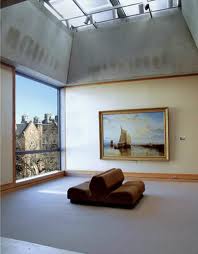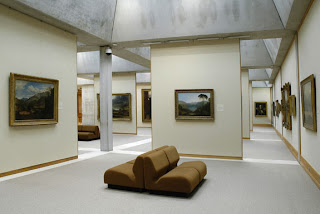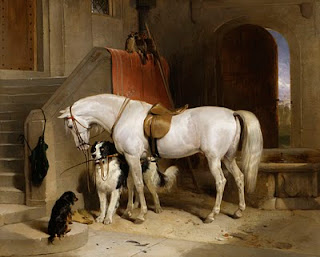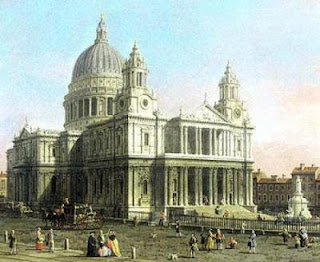 The interior of the YCBA is very comfortable and welcoming. I like a museum where there are lots of seats where one can sit and look at the pictures — and this gallery has the added advantage of windows to the outside. The picture in the center is by Joseph Mallord William Turner (1775-1851), a work with the kind of realistic detail he later eschewed. It is titled Dordrecht, the Dort Packet-boat from Rotterdam Becalmed painted in 1818. I love almost everything by Turner but this particularly engages me.
The interior of the YCBA is very comfortable and welcoming. I like a museum where there are lots of seats where one can sit and look at the pictures — and this gallery has the added advantage of windows to the outside. The picture in the center is by Joseph Mallord William Turner (1775-1851), a work with the kind of realistic detail he later eschewed. It is titled Dordrecht, the Dort Packet-boat from Rotterdam Becalmed painted in 1818. I love almost everything by Turner but this particularly engages me. Here is another view of the galleries, photos attributed to Richard Caspole. Although I wouldn’t mind being the only patron for a few hours, I must say the place has never been empty when I visited. The building was designed by was Louis I. Kahn (1901-1974), once a professor of architecture at Yale, and a leading American mid-century architect. The YCBA is immediately across the street from the Yale Art Gallery, also designed by Kahn, now undergoing renovations.
Here is another view of the galleries, photos attributed to Richard Caspole. Although I wouldn’t mind being the only patron for a few hours, I must say the place has never been empty when I visited. The building was designed by was Louis I. Kahn (1901-1974), once a professor of architecture at Yale, and a leading American mid-century architect. The YCBA is immediately across the street from the Yale Art Gallery, also designed by Kahn, now undergoing renovations. The YCBA has an excellent collection of works by George Stubbs (1724-1806). This picture of Pumpkin with a Stable-lad was one of the first purchases of British art made by Paul Mellon (1907-1999), whose collection is the nucleus of the YCBA. Mellon was particularly fond of sporting pictures and of Stubbs in particular. His father, Andrew Mellon, his uncle and grandfather were the scions of the Mellon Bank and one of America’s greatest fortunes. Andrew and Paul Mellon were responsible for the creation of the National Gallery of Art in Washington, D. C. and gave the Andrew Mellon collection as its most important bequest.
Stubbs was a favorite painter of Paul Mellon, from his racing horses (which reflected Mello
n’s interest in horseracing) to his exotic animals to his dramatically violent pictures of beasts attacking horses. The view to the left, Zebra, dates from 1762–63. Again, the photo is from the YCBA by Richard Caspole. As Zebra was the name of my former publisher, I have a special fondness for the little fellow.
Equally beautiful but shockingly violent is the 1762 painting Lion Attacking a Horse, one of several such views Stubbs painted after supposedly witnessing a similar event while traveling abroad. I guess it makes the scene even more upsetting to us to note that the horse looks much like Trigger.
Paul Mellon graduated from Yale University and was the major benefactor for the YCBA, both the building and the collection.
Continuing the horsey theme with a more mellow view, this painting by Edward Landseer (1802-1873) depicts The Favourites, the property of H.R.H. Prince George of Cambridge, as seen in 1834-5. Landseer had a way with animals, didn’t he?
A love for horses and British art are probably the only qualities I share with the late Paul Mellon, but I certainly appreciate his taste and his philanthropy. The Virginia Museum of Fine Arts in Richmond, VA, has also benefited from the Mellon’s donations of British Sporting Art.
At right is Eagle, A Celebrated Stallion, by James Ward (1769-1859) painted in 1809.
According to the YCBA, the picture “exhibits Ward’s remarkable ability to create an accurate physical portrayal of a particular animal. He also evokes a transcendent romantic type suggesting the latent power of the barely tamed creature is full of drive, dash, and tension…” As you may have guess, I am a bit horse-crazy myself. Though, looking at these magnificent specimens, who isn’t?

St Paul’s Cathedral by Canaletto, at right. The Italian artist lived in London from 1746 to 1755 and painted many views of England, probably none more magnificently than this. The cathedral, designed by Sir Christopher Wren in a nearly-Italian baroque style, had been finished in 1710, after its predecessor had been destroyed in the Great Fire of London in 1666. It must have looked much more familiar to the Venetian Canaletto than other, gothic-style London churches.
Coming soon, a visit to Yale’s Beinecke Rare Book and Manuscript Library…and more Canaletto from Washington, D.C.




